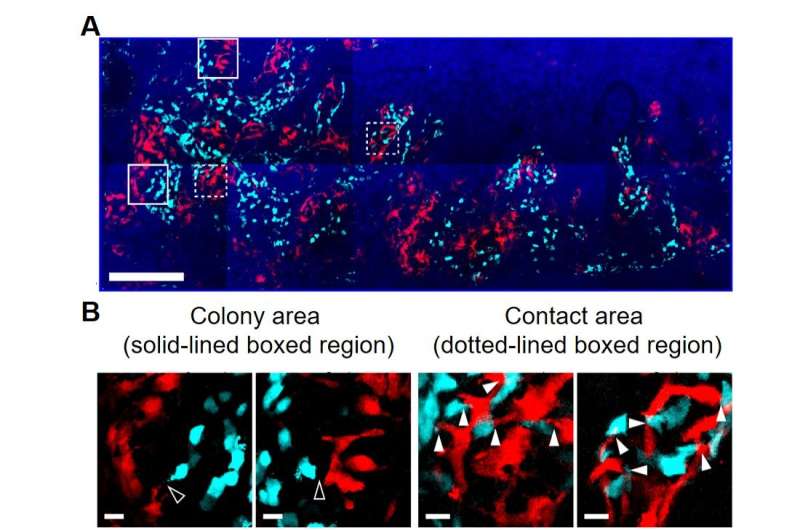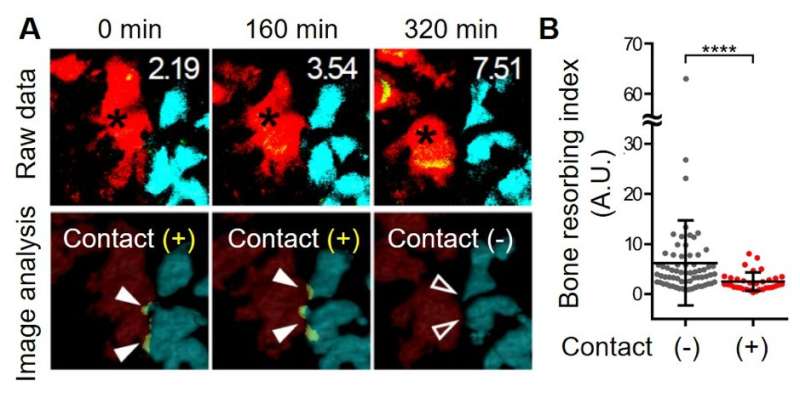Clarifying the interplay between bone cells in bone remodeling

Bones have numerous functions, including providing mechanical support of soft tissues, acting as levers for muscle action, and protecting the central nervous system. To accomplish their functions, bones undergo continuous destruction (resorption) carried out by osteoclasts, and formation by osteoblasts.
In the adult skeleton, the two processes must be in balance to maintain a constant, controlled amount of bone. An imbalance in the regulation can result in metabolic bone diseases, such as osteoporosis. Therefore, it is important to understand the spatial-temporal relationship and interaction between osteoblasts and terminally differentiated osteocytes (bone cells) and osteoclasts in vivo. However, it remains controversial whether these cell types physically interact with each other in bone remodeling. A multicenter study centered at Osaka University was conducted to elucidate this knowledge. The findings were recently published in Nature Communications.
"Using an intravital two-photon microscopy technique we developed, we investigated the communication between mature osteoblasts (mOBs) and mature osteoclasts (mOCs) in vivo," study first author Masayuki Furuya explains. "mOBs and mOCs were visualized simultaneously in living skull bone tissues from transgenic mice that express enhanced cyan fluorescent protein (ECFP) driven mOBs and a red fluorescing protein controlled by mOCs."
Intravital two-photon bone imaging is superior compared with conventional analyses of the shape and form of a tissue because it enables two-dimensional scanning in bone in a focal plane to observe cell shapes and the appearance of mOBs and mOCs in the body. Through this visualization method, the researchers successfully captured images of osteoblasts and osteoclasts interacting in real-time in living bone tissue. Next, the number and duration of mOB-mOC contact was analyzed using three-dimensional colocalization. mOBs and mOCs were found to mainly occupy discrete territories in the bone marrow in the steady state, although direct cell-to-cell contact exist in a spatiotemporally limited fashion.

Additionally, using a pH-sensing fluorescence probe, the team found that mOCs secrete protons (subatomic particles with a positive electrical charge) for bone resorption when they are not in contact with mOBs, whereas mOCs contacting mOBs are non-resorptive, suggesting that mOBs can inhibit bone resorption by direct contact.
"Although the molecular mechanisms involved in direct cell contact remain elusive, our study clearly demonstrates an important concept that dynamic communication between mOBs and mOCs regulates bone homeostasis," corresponding author Masaru Ishii says. "Our results have potential to lead to development of a new line of therapy for modifying the association properties of these two cell types, especially in osteoporosis and tumor metastasis in bones."
More information: Masayuki Furuya et al. Direct cell–cell contact between mature osteoblasts and osteoclasts dynamically controls their functions in vivo, Nature Communications (2018). DOI: 10.1038/s41467-017-02541-w

















